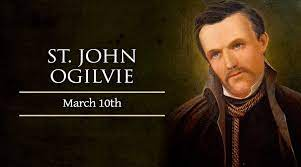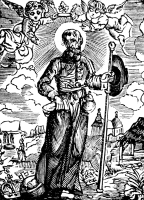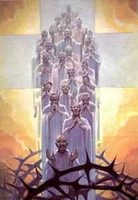Saint Marie-Eugénie de Jésus
Also known as
• Anne-Eugénie Milleret de Brou
• Eugénie Milleret de Brou
• Eugénie Milleret de Bron
• Marie Eugénie Milleret de Brou
• Mere Marie Eugénie
Profile
Raised in an educated and intellectual family with no faith, but who apparently went through some of the motions since she received her first Communion on Christmas 1829 at age twelve. She had a conversion experience, came to the faith, and felt a call to religious life by hearing the Lenten sermons of the Dominican Henri Lacordaire at the Cathedral of Notre Dame in Paris, France. She made a short novitiate with the Sisters of the Visitation at Cote Saint-Andre, but did not take vows.
During a pilgrimage to the shrine of Sainte-Anne d'Auray in 1825, Eugenie felt called to found a teaching institute that would work in the world, but kept monastic observances. In 1839 she founded the group later named the Congregation of the Assumption (Religious of the Assumption, Sisters of the Assumption) to perform this mission. The Assumptionists received papal approval in 1888, and continue their good work in 34 countries around the world today.
Born
26 August 1817 at Metz, Moselle, France as Eugenie Milleret de Brou (de Bron)
Died
10 March 1898 at Auteuil, Hauts-de-Seine, France of natural causes
Canonized
3 June 2007 by Pope Benedict XVI
Saint John Ogilvie
புனிதர் ஜான் ஓகில்வீ
யேசு சபை குரு மற்றும் மறைசாட்சி:
பிறப்பு: கி.பி. 1579
ட்ரம்நகேத், பன்ஃப்ஷைர், ஸ்காட்லாந்து
இறப்பு: மார்ச் 10, 1615
க்ளஸ்கோவ் க்ராஸ், ஸ்காட்லாந்து
ஏற்கும் சமயம்:
ரோமன் கத்தோலிக்க திருச்சபை
முக்திபேறு பட்டம்: 1929
திருத்தந்தை பதினோராம் பயஸ்
புனிதர் பட்டம்: 1976
திருத்தந்தை ஆறாம் பால்
நினைவுத் திருநாள்: மார்ச் 10
புனிதர் ஜான் ஓகில்வீ, ஒரு ஸ்காட்லாந்து நாட்டின் இயேசு சபை குருவும், ரோமன் கத்தோலிக்க திருச்சபையின் புனிதரும் ஆவார்.
இவர் "வால்ட்டர் ஓகில்வீ" (Walter Ogilvie) என்பவரது மூத்த மகன் ஆவார். இவரது தந்தை ஒரு மதிப்பு மிக்க "கால்வினீய" (Calvinist) சமுதாயத்தைச் சார்ந்த செல்வந்தர் ஆவார்.
ஜான் பன்னிரெண்டாவது வயதில் கல்வி கற்பதற்காக ஐரோப்பிய நாடுகளுக்கு அனுப்பப்பட்டார். அவர், ஜெர்மனியில், "பெனடிக்டைன்" (Benedictines) சபையினரின் கீழுள்ள பல்வேறு கத்தோலிக்க கல்வி நிறுவனங்களிலும், "மொராவியா" (Moravia) நாட்டிலுள்ள இயேசு சபையின் (Jesuits) கீழுள்ள கல்வி நிறுவனங்களிலும் கல்வி கற்றார்.
அக்காலத்தைய சமய சர்ச்சைகளும் கொந்தளிப்புகளும் ஐரோப்பா கண்டத்தையே மூழ்கடித்திருந்தன. ஜான் ஒரு கத்தோலிக்கராக மாற முடிவெடுத்திருந்தார். 1596ம் ஆண்டில், தமது பதினேழாவது வயதில் ஜான் “பெல்ஜியம்” (Belgium) நாட்டில் கத்தோலிக்க திருச்சபையினால் ஏற்றுக்கொள்ளப்பட்டார். இயேசு சபையில் இணைந்த இவர், 1610ம் ஆண்டு, “பாரிஸ்” (Paris) நகரில் குருத்துவ அருட்பொழிவு பெற்றார்.
குருத்துவ அருட்பொழிவு பெற்ற ஜான், அதன்பின்னர் "நார்மண்டி" (Normandy) எனுமிடத்தில் பணியாற்றினார். ஸ்காட்லாந்து நாட்டில் மீதமிருந்த ஒரு சில கத்தோலிக்க மக்களுக்கு பணியாற்ற அனுப்பும்படி அடிக்கடி வேண்டினார். (அக்காலத்தில், 1560ம் ஆண்டுகளில், ஸ்காட்லாந்து நாட்டில் கத்தோலிக்க மறை போதனை செய்வதோ, மதமாற்றம் செய்ய முயற்சிப்பதோ கூட சட்ட விரோதமாக அறிவிக்கப்பட்டிருந்தது.)
கத்தோலிக்க பிரபுக்கள் யாராவது தமக்கு உதவுவார்கள் என எதிர்பார்த்தார். ஆனால், யாரும் உதவ முன்வராததால் அவர் அங்கிருந்து லண்டன் நகர் சென்றார். பின்னர் அங்கிருந்து மீண்டும் பாரிஸ் நகர் திரும்பினார். இறுதியில், 1613ம் ஆண்டு நவம்பர் மாதம், "ஜான் வாட்ஸன்" (John Watson) என்ற பெயரில் ஒரு குதிரை வியாபாரி போன்று மாறுவேடத்தில் ஸ்காட்லாந்து நாட்டில் நுழைந்தார். அதன்பின்னர், அவர் இரகசியமாக மறை போதனை செய்யத் தொடங்கினார். பிரத்தியேக வீடுகளில் மறைவாக திருப்பலிகள் நிறைவேற்றினார்.
சுமார் ஒன்றரை வருடங்களே ஸ்காட்லாந்து நாட்டில் மறைப்பணியாற்றிய ஜான், கண்டுபிடிக்கப்பட்டு, 1614ம் ஆண்டு, அக்டோபர் மாதம், கைது செய்யப்பட்டார். அங்கிருந்த எதிர்கத்தோலிக்க பேராயர் "ஸ்பாட்டிஸ்வுட்" (Archbishop Spottiswood) என்பவரது உத்தரவின்படி சிறையிலடைக்கப்பட்டார். 26 மணி நேரத்துக்கு மேலாக அவருக்கு உணவு ஏதும் கொடுக்கப்படவில்லை. அவர், தமது செய்கைக்கு மன்னிப்பு கேட்க மறுத்துவிட்டார். கொடூரமாக துன்புறுத்தப்பட்டார். சிறையில் அவரை உறங்க விட மறுத்தனர். அவரது கூட்டாளிகளைக் காட்டிக்கொடுக்குமாறு வற்புறுத்தப்பட்டார். ஆனால், அவர் எவர் பெயரையும் சொல்ல மறுத்துவிட்டார்.
அரசன் "ஜேம்சுக்கு" (King James) விசுவாசம் காட்டும் உறுதிமொழி ஏற்க மறுத்ததால் அவரது நிலை மேலும் மோசமடைந்தது. எட்டு நாட்கள் இரவும் பகலும் அவர் அங்குமிங்கும் இழுத்துச் செல்லப்பட்டார். கூரிய மரக்குற்றிகளால் குத்தப்பட்டார். அவரது தலை மயிர்கள் பிடுங்கப்பட்டன. இருப்பினும் அவர் தமது கூட்டாளிகளைக் காட்டிக்கொடுக்க மறுத்துவிட்டார். அத்துடன் அரசனுக்கு தமது மத விசுவாசத்தினையும் அறிக்கையிட மறுத்துவிட்டார்.
நீதிமன்ற இறுதி விசாரணையின்போது ஜான் கூறியதாவது:
"நான் என் அரசனின் அனைத்து ஆணைகளுக்கும் ஒரு அடிமையாக கீழ்படிய தயாராக இருக்கிறேன். அவரது ஆட்சிக்கு ஏதும் ஆபத்து வருமெனில், நான் என்னுடைய கடைசி சொட்டு இரத்தம் வரை சிந்த தயாராக இருக்கிறேன். ஆனால், எனது ஆன்மீக வரம்பினை அவர் அநியாயமாக குலைப்பதனை என்னால் பொறுத்துக்கொள்ளவோ, கீழ்படியவோ இயலாது."
துரோகி என்று தீர்ப்பளிக்கப்பட்ட ஜானுக்கு மரண தண்டனை அளிக்கப்பட்டது. "கத்தோலிக்கர் எவராவது இங்கே மறைந்து இருப்பின், அவர்கள் எனக்காக ஜெபிக்கட்டும். ஆனால், கத்தோலிக்கர்களுக்கு எதிரானவர்களின் ஜெபம் எனக்கு வேண்டாம்" என்று ஜான் இறுதியாகக் கூறினார்.
தூக்கு மேடைக்கு இழுத்துச் செல்லப்பட்ட ஜான், படிக்கட்டுகளில் தள்ளி விடப்பட்டார். அப்போது, ஜான் தம்மிடம் மறைத்து வைத்திருந்த ஜெபமாலையை தூக்கி கூட்டத்தினரிடையே விட்டெறிந்தார். அதனை எம்பிப் பிடித்த அவரது எதிரி ஒருவன் பக்தி விசுவாசமுள்ளவனாக மாறினான். இறுதிவரை அவன் கத்தோலிக்கனாகவே வாழ்ந்தான் என்றும் கூறப்படுகின்றது.
இறுதிவரை, தூக்குமேடையிலும் அவர் உண்மையாக இருந்தார். சிறைச்சாலையிலும், மரணம் வரையிலும் அவரது தைரியம் ஸ்காட்லாந்து நாடு முழுவதும் அறிவிக்கப்பட்டது.
ஜானின் மரணத்தின் பின்னர், அவரைப் பின்பற்றிய அனைவரும் சுற்றி வளைக்கப்பட்டு சிறையிலடைக்கப்பட்டனர். அனைவருக்கும் கடும் தண்டனைகள் அளிக்கப்பட்டன. ஆனால் ஒருவருக்குக் கூட மரண தண்டனை அளிக்கப்படவில்லை.
Profile
Walter Ogilvie was a Scottish noble who raised his son John in the state religion of Scotland, Calvinism. John converted to Catholicism at age 17 at Louvain, Belgium, and then attended several Catholic educational institutions. He joined the Jesuits soon after in 1597, and was ordained in Paris, France in 1610. Sent to work in Rouen, France.
It was a time of great persecution of Catholicism in Scotland. "Send only those," wrote the Earl of Angus to the Jesuit General, "who wish for this mission and are strong enough to bear the heat of the day, for they will be in exceeding danger." Wholesale massacres of Catholics had taken place in the past, but by this point the hunters concentrated on priests and those who attended Mass. The Jesuits were determined to minister to the oppressed Catholic laity, but when captured, they were tortured for information, then hanged, drawn, and quartered.
Ogilvie repeatedly requested assignment to his home Scotland, and it was finally granted; he returned in November 1613. He worked as an underground missionary in Edinburgh and Glasgow, dodging the Queen's priest-hunters, disguised as a soldier named Watson. After 11 months in the field (and on the run), John was betrayed by a phony Catholic, imprisoned, interrogated, then tortured for the names of active Catholics. He gave no information. "Your threats cheer me; I mind them no more than the cackling of geese," he told his captors. Asked if he feared to die Father John replied, "No more than you do to dine."
After three trials he was convicted of treason for being loyal to the Pope, and denying the king's supremacy in spiritual matters. He is the Church's only officially recorded Scottish martyr.
Born
1579 at Drum, Grampian, Scotland
Died
• hanged 10 March 1615 at Glasgow, Scotland
• no relic of his body has survived
Canonized
17 October 1976 by Pope Paul VI
Blessed Elias del Socorro Nieves
Also known as
Mateo Elias Nieves
Profile
Born a sickly baby in a deeply religious peasant family; had to be quickly baptized as they did not think he would survive. Nearly died of tuberculosis at age 12. His father died soon after, and Elias had to support the family. Admitted to the Augustinian college of Yuriria at age 22, considerably older than the standard admission age. Took vows in 1911 as Elias del Socorro. Ordained on 9 April 1916. Parochial vicar of the village of La Canada de Caracheo in 1921. During the government persecution of the Church, he refused to a city where he could be controlled; moving instead to nearby hills where he continued to serve his parish, usually under cover of dark. Arrested with some pious laymen, and martyred on the side of the road for his faith and service.
Born
21 September 1882 at San Pedro, Yuriria, Guanajuato, Mexico as Mateo Elias Nieves
Died
shot by soldiers under the command of Captain Manuel Marquez Cervantes on 10 March 1928
Beatified
12 October 1997 by Pope John Paul II
Pope Saint Simplicius
Profile
Son of Castinus. Held the pontificate during the end of the Roman Empire. He defended the Council of Chalcedon against the Monophysites heresy of the Eastern empire. Worked for the Italian people against barbarian invaders. Built four large churches in Rome, and brought some order and organization to the administration of the sacraments in the local churches, bringing the focus back to the sacrament rather than the place of its administration. Opposed Emperor Leo who wanted to officially make the Patriarch of Constantinople second only to the pope in authority. Worked to support orthodox Christianity against the Arianism promoted by King Odoacer.
Born
at Tivoli, Italy
Papal Ascension
3 March 468
Died
• 10 March 483 of natural causes
• interred in Saint Peter's Basilica, Vatican City, Rome, Italy
Blessed John of Vallombrosa
Also known as
John of the Holy Trinity
Profile
Benedictine Vallombrosan monk at Florence, Italy, taking the religious name John of the Holy Trinity. Developed a fascination with black magic, and began to study and practice it in secret, collecting occult and forbidden writings. Eventually found out and summoned before the abbot-general of the Vallumbrosans, John first denied his studies, then confessed. He was imprisoned by the Order, which proved to be his salvation. The solitude led him to true penitence, and some severe self-imposed autsterities. Seeing his conversion, his brothers asked that he return to the community, but he refused, preferring the saving solitude of his cell. He lived to old age as a hermit, writing, and receiving visions of Saint Catherine of Siena.
Born
c.1310 at Florence, Italy
Died
c.1395 at Vallombrosa, Florence, Italy of natural causes
Blessed Wirnto of Formbach
Also known as
• Wirnto of Göttweig
• Wirnto of Vornbach
• Wirnto of Vormbach
• Wirnto Formbacensis
Additional Memorial
29 October (day of election as abbot)
Profile
Benedictine monk at the Saint Blase monastery in the Black Forest in Germany. Prior of Göttweig monastery in Austria. Monk at Formbach in Lower Bavaria (in modern Germany) in 1107 where he worked with Blessed Beregar. Abbot of Formbach on 29 October 1108. Noted for his personal austerities, he brought the reforms to religious life that he had learned in his previous houses. A miracle worker and healer, he oversaw a large expansion to the abbey.
Born
11th century
Died
• 10 March 1127 at Formbach, Bavaria, Germany of natural causes
• interred with Blessed Berengar at Göttweig Abbey
Beatified
13th century
Saint Attalas of Bobbio
Also known as
Attal, Attala, Attale
Profile
Monk at Lérins, France. Monk at Luxeuil Abbey. Helped Columbanus build the abbey in Bobbio, Italy. Served as its abbot from 615. During Attalas's abbacy most of the monks stood out against the severity of the Columbanian Rule. His monks included Saint Valery and Saint Blitmund of Bobbio.
Born
in Burgundy, France
Died
• 627 of natural causes
• relics at the Abbey of Saint Colombano , Bobbio, Provincia di Piacenza, Emilia-Romagna, Italy
Saint Kessog
Also known as
Kassog, Kecsag, Kessag, Kessoge, Machessagus, Mackecsog, Mackessog, Mackessoge, Makkessog, Makkessoge
Profile
Son of the king of Cashel, Ireland, Kessel grew up a pious child, and was known as a miracle worker. Missionary bishop to Scotland in the area of Lennox and southern Perthshire, working from Monk's Island in Loch Lomond. May have been martyred at Bandry, Scotland, but records are unclear. His name was used as a battle cry by the Scots, and the Kessog oil field in the North Sea is named after him.
Born
at Cashel, Tipperary, Ireland
Died
c.560 of natural causes
Forty Martyrs of Armenia
Also known as
• Forty Armenian Martyrs
• Forty Martyrs of Christ
• Forty Martyrs of Sebaste
Profile
Forty Christian soldiers of the Thunderstruck Legion of the Imperial Roman army who were tortured and murdered for their faith during the persecutions of Emperor Licinius.
A group of forty Christian soldiers martyred by Emperor Licinius Licinianus at Sebaste, in modern Armenia. They are also called the Martyrs of Sebaste. The martyrs were forced to march naked upon the ice of a frozen lake after they refused to abjure the faith. Upon the shore were kept warm baths and hot food as inducements for abjuring Christ. One soldier gave up the faith unable to endure any more cold, and an officer of the pagan units maintaining the baths declared this to be a dishonorable act and marched out onto the ice to take the lapsed Christian's place. The martyrs were praised by Sts. Basil, Gregory of Nyssa, and others. Their cult was suppressed in 1969.
Died
• exposed naked on a frozen pond to freeze to death at Sebaste, Armenia in 320
• bodies afterward burned
Saint Anastasia the Patrician
Also known as
• Anastasia of Skete
• Anastasia the Eunuch
• Anastasius...
Profile
Christian Byzantine noble. Lady-in-waiting to the Empress Theodora in Constantinople. To escape the unwanted attentions of the Emperor Justinian, Anastaia fled the court to a convent in Alexandria, Egypt. On the death of Theodora, Justinian launched a search for Anastasia. To escape, she assumed a male identity and costume, and lived her remaining 28 years as a hermit in the desert of Scete.
The story is believed by many modern scholars to be a pious legend.
Died
c.507 of natural causes
Blessed Jean-Marie Joseph Lataste
Also known as
Alcide-Vital Lataste
Profile
Dominican. Ordained in 1863. Founded the Dominican Sisters of Bethany in 1867; the sisters continue their work today with abused women in several European locations.
Born
5 September 1832 in Cadillac-sur-Garonne, Gironde, France as Alcide-Vital
Died
10 March 1869 in Frasne-Le-Château, Haute-Saône, France of natural causes
Beatified
3 June 2012 by Pope Benedict XVI
Saint Macarius of Jerusalem
Also known as
Macario
Profile
Bishop of Jerusalem in 314. Fought Arianism. Participated in and signed the documents of the Council of Nicaea, and helped formulate the Nicene Creed. When Saint Helena discovered a collection of crosses, one of which was the True Cross, Macarius suggested identifying the real one by touching them to a seriously ill woman, and seeing which one cured her. Supervised the construction of the church of the Holy Sepulcher.
Died
335 of natural causes
Saint Codratus of Nicomedië
Profile
Fed and ministered to prisoners who were arrested and tortured in the persecutions of Emperor Valerian. When the prisoners were taken into the court for their show trial and the judge began questioning them, none would speak. Finally Codratus called out from the gallery, "We are all Christians, servants of our Lord Jesus Christ." Martyr.
Died
c.258 in Nicomedië, Asia Minor (in modern Turkey)
Saint Andrew of Strumi
Also known as
Andrew the Ligurian
Profile
Benedictine. Spiritual student and chief supporter of Saint Arialdo of Milan in the campaign against simony in Milan, Italy. Vallombrosan monk. Abbot of San Fedele at Strumi on the Arno. Peacemaker between the Italian cities of Florence and Arezzo. Biographer of Saint John Gualbert and Saint Arialdo.
Born
at Parma, Italy
Died
1097 of natural causes
Saint Himelin
Also known as
Himelinus, Hymelin, Imelino
Profile
Relative of Saint Rumold. Priest. Died en route home from a pilgrimage to Rome, Italy. While he was apparently on his death bed, a young woman gave him a pitcher of water, which he turned into wine.
Born
Ireland
Died
c.750 at Vissenacken, Belgium of natural causes
Saint Droctoveus
Also known as
Droctonius, Droctovée, Droctovius, Drote, Drottoveo, Drotté
Profile
Monk in abbies in Paris, France. Spiritual student of Saint Germanus of Paris. Abbot of Saint Symphorium abbey at Autun, France. First abbot of what became known as Saint Germain-des-Pres in Paris.
Born
in Auxerre, France
Died
c.580 of natural causes
Saint Victor of North Africa
Profile
Marytred in the persecutions of Decius. Saint Augustine wrote about him.
Died
c.250 in North Africa
Saint Caius of Apema
Also known as
Gaius, Cajus, Caio
Profile
Missionary preacher in the area of Apema, Phrygia (part of modern Turkey). Worked with Saint Alexander of Apema. Fought the Montanist heresy. Martyred in the persecutions of Emperor Marcus Aurelius.
Died
martyred c.172
Saint Gustav the Hermit
Also known as
Götstaf the Hermit
Profile
May have been the first person in Sweden baptized by Saint Ansgar of Hamburg-Bremen. Hermit in northern Sweden.
Born
c.810 in Sweden
Died
10 March 890 in northern Sweden of natural causes
Saint Alexander of Apema
Profile
Missionary preacher in the area of Apema, Phrygia (part of modern Turkey). Worked with Saint Caius of Apema. Fought the Montanist heresy. Martyred in the persecutions of Emperor Marcus Aurelius.
Born
in Eumenes, Phrygia
Died
c.172
Saint Emilian of Lagny
Also known as
Aemilianus, Emilien, Eminian, Imelin
Profile
Benedictine monk. Monk and then abbot at Lagny, France.
Born
Irish
Died
c.675 of natural causes
Saint Saturninus of Nicomedië
Profile
Arrested, tortured and executed in the persecutions of Emperor Valerian.
Died
c.258 in Nicomedië, Asia Minor (in modern Turkey)
Saint Rufinus of Nicomedië
Profile
Arrested, tortured and executed in the persecutions of Emperor Valerian.
Died
c.258 in Nicomedië, Asia Minor (in modern Turkey)
Saint Peter of Veroli
Profile
Hermit near Veroli, Italy.
Born
Spain
Died
• near Veroli, Italy of natural causes
• miracles reported at his tomb
Saint Sedna of Ossory
Profile
Benedictine monk. Abbot of Seir-Kieran abbey. Bishop of Ossory, Ireland. Friend of Saint Luanus.
Died
c.570 of natural causes
Saint Mariana of Britonia
Also known as
Marina
Profile
Martyred nun.
Died
in Britonia, Asturias (in modern Spain)
Saint Failbhe the Little
Profile
Abbot of Iona Abbey for seven years.
Born
c.674
Died
754 of natural causes
Saint Sannudius of Bagensena
Profile
Martyred in the persecutions of Maximian.
Died
c.303 in Bagensena, Italy
Saint Silvester of Ireland
Profile
Evangelist in Ireland with Saint Palladius of Ireland.
Died
c.420
Saint Blanchard
Profile
I can find no biographical information on this person.
Died
relics honored at Nesle-le-Reposte, France
Saint Agapa of Britonia
Profile
Martyred nun.
Died
in Britonia, Asturias (in modern Spain)
Anonymous Martyrs of Persia
Profile
A group of 42 Christians martyred in Persia in the 4th century.























